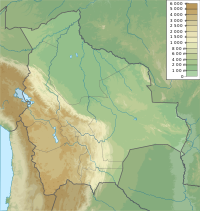
Sebastián Pagador is a province in the southeastern parts of the Bolivian department of Oruro. Its seat is Santiago de Huari.
Kachi Mayu is a Bolivian river east of Poopó Lake in the Oruro Department, Challapata Province, Challapata Municipality. Its source, the Jach'a Juqhu River, is considered the origin of the Pillku Mayu.
Qullpa Jawira is a Bolivian river east of Poopó Lake in the Oruro Department, Challapata Province, Challapata Municipality, and in the Santiago de Huari Municipality. It originates near Ch'iyar Jaqhi northeast of Jatun Wila Qullu and flows in a north-eastern direction. South of Wila Qullu it meets the T'ula Pallqa River whose source, the Jach'a Juqhu River, is considered the origin of the Pillku Mayu.

Ch'iyar Jaqhi is a 4,937-metre-high (16,198 ft) mountain located in the Andes in Bolivia. It is situated in the Oruro Department, Sebastián Pagador Province, in the south of the Condo "C" Canton. It lies between the mountains Jatun Wila Qullu in the south-west and Wila Qullu in the north-east. One of the nearest mountains is Jach'a Jaqhi (Jachcha Jakke) north-east of it. The river Qullpa Jawira originates near Ch'iyar Jaqhi.

Challuma is a 5,187-metre-high (17,018 ft) mountain in the Andes of southern Peru near a lake of the same name. It is situated in the Moquegua Region, Mariscal Nieto Province, Carumas District, and in the Tacna Region, Candarave Province, Candarave District. It lies northeast of the mountain Churilaca.

Wila Sirka is a 4,906-metre-high (16,096 ft) mountain in the Andes of Bolivia. It is located in the Oruro Department, Sebastián Pagador Province, which is identical to the Santiago de Huari Municipality. Wila Sirka lies between the mountains Azanaques in the west and Sirk'i in the east.

Ari Qullu Phujru is a 4,974-metre-high (16,319 ft) mountain in the Cordillera Occidental in the Andes of Bolivia. It is situated in the Oruro Department, Sajama Province, Turco Municipality, Chachacomani Canton, south-east of the volcanic complex of Kimsa Chata.
Janq'u Quta is a lake in the Cordillera Real in the Andes of Bolivia. It is located in the La Paz Department, Larecaja Province, in the south-west of the Guanay Municipality. Janq'u Quta lies near the mountain Ch'iyar Juqhu.

P'ukru or Phujru is a 4,768-metre-high (15,643 ft) mountain in the Potosí mountain range in the Bolivian Andes. It is situated in the Potosí Department, Tomás Frías Province, in the south of the Potosí Municipality. P'ukru lies southwest of Khunurana and a mountain named Q'umir Qucha.

Chullpiri is a 5,018-metre-high (16,463 ft) mountain in the Andes of Bolivia east of Poopó Lake. It is located in the Oruro Department, Sebastián Pagador Province, which is identical to the Santiago de Huari Municipality. Chullpiri lies southeast of Wila Sirka and Sirk'i and northeast of Ch'alla Phujru. It is situated south of the Anta Qullu valley.

Sirk'i is a 4,962-metre-high (16,280 ft) mountain in the Andes of Bolivia east of Poopó Lake. It is located in the Oruro Department, Sebastián Pagador Province, which is identical to the Santiago de Huari Municipality. Sirk'i lies northwest of Chullpiri and east of Wila Sirka.

Chullpa is a 4,307-metre-high (14,131 ft) mountain in the Andes of Bolivia east of Poopó Lake. It is located in the Oruro Department, Sebastián Pagador Province, which is identical to the Santiago de Huari Municipality. Chullpa lies north-west of the mountain Chullpani and south-east of the mountains Wari Pukyu (Huari Pukio, Huari Pujyo), and Chullpa Qullu (Chullpa Kkollu). It is situated near the Parya River.

Ch'alla Qullu is a mountain in the Chilla-Kimsa Chata mountain range in the Andes of Bolivia which reaches a height of about 4,660 m (15,290 ft). It is located in the La Paz Department, Ingavi Province, Jesús de Machaca Municipality. Ch'alla Qullu lies northwest of Chhuxlla Willk'i. The Ch'uñu Jawira originates near the mountain. It flows to the south as a right affluent of the Jach'a Jawira.

Ch'alla Willk'i is a 4,543-metre-high (14,905 ft) mountain in the Andes of Bolivia. It is located in the Oruro Department, Sajama Province, in the north of the Turco Municipality. Ch'alla Willk'i is situated northeast of Tankani and Mamaniri.

Ch'alla Willk'i is a mountain in the Bolivian Andes, about 4,940 m (16,210 ft) high. It is situated in the La Paz Department, Murillo Province, La Paz Municipality, east of the main range of the Cordillera Real. Ch'alla Willk'i lies between Kunturiri in the southwest and Llust'a in the northeast, and northwest of Turini. A little river named Ch'iyar Jawira originates near the mountain. It flows to the northeast.
Ch'alla Quta is a lake in the Cordillera Real in the Andes of Bolivia. It is situated in the La Paz Department, Larecaja Province, Sorata Municipality. Ch'alla Quta lies south of the mountain Larama Punta.
The Ch'alla Jawira which upstream is named Ch'api K'uchu and downstream successively is called Tupa Jawira and Qura Jawira is a river in the La Paz Department in Bolivia. It is a right affluent of the Aqhuya Jawira whose waters flow to the Desaguadero River.
The Ch'alla Jawira is a river in the La Paz Department in Bolivia. It is a left tributary of the Tiwanaku River which empties into Wiñaymarka Lake, the southern part of Lake Titicaca.

Kimsa Phujru is a mountain in the western extensions of the Cordillera Real in the Andes of Bolivia which reaches a height of approximately 4,220 m (13,850 ft). It is located in the La Paz Department, Los Andes Province, Batallas Municipality. Kimsa Phujru lies at the Pura Purani River, an affluent of the Qiqa Jawira.

Jaqhi Qala is a mountain in the Andes of Bolivia which reaches a height of approximately 5,000 m (16,000 ft). It is located in the Oruro Department, at the border of the Challapata Province, Challapata Municipality, and the Sebastián Pagador Province which is identical to the Santiago de Huari Municipality. Jaqhi Qala lies southwest of Phullu Qiri, northwest of Sirk'i and south of Chumpiri. The Jach'a Qala River originates at the mountain. It flows to the south.









